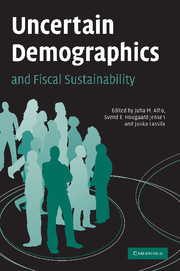Book contents
- Frontmatter
- Contents
- List of figures
- List of tables
- List of contributors
- Preface
- 1 Introduction
- Part I Uncertain demographics
- Part II Measuring sustainability in a stochastic environment
- 4 Fiscal implications of demographic uncertainty: comparisons across the European Union
- 5 Demographic uncertainty and pension projections
- 6 Demographic uncertainty and health care expenditure
- Comment: Assessing the uncertainty in long-term fiscal projections
- Part III Enhancing sustainability
- Part IV Extensions
- Index
- References
6 - Demographic uncertainty and health care expenditure
Published online by Cambridge University Press: 22 September 2009
- Frontmatter
- Contents
- List of figures
- List of tables
- List of contributors
- Preface
- 1 Introduction
- Part I Uncertain demographics
- Part II Measuring sustainability in a stochastic environment
- 4 Fiscal implications of demographic uncertainty: comparisons across the European Union
- 5 Demographic uncertainty and pension projections
- 6 Demographic uncertainty and health care expenditure
- Comment: Assessing the uncertainty in long-term fiscal projections
- Part III Enhancing sustainability
- Part IV Extensions
- Index
- References
Summary
Introduction
One of the areas where population ageing will be particularly relevant is health care expenditure. National health expenditure already takes a substantial share of GDP in most developed countries. During the last few decades, it has increased across OECD countries. In 2003, OECD countries devoted, on average, 8.8% of their GDP to health spending, up from 7.1% in 1990 and just over 5% in 1970. However, the share of GDP allocated to health spending varies considerably across countries, ranging from less than 6% in the Slovak Republic, through 7.7% in Spain to 15% in the United States in 2003 (OECD, 2005a). Accelerating ageing of the population forecast for the first half of this century poses a serious challenge for the sustainability of the current social welfare system in Europe.
The direct link between population ageing and national health expenditure is due to the fact that per-capita health spending increases with age. The estimated ratio of per-capita health spending for a person aged 65 or over to that for a person under 65 years ranges between 2.5 and 5 in developed countries (see, for example, Anderson and Hussey, 2000), and within the elderly (aged 65 or greater) population a sharp increase in health expenditure with age is also observed in all countries (Economic Policy Committee, 2001). Increasing health spending with age accompanied by population ageing implies larger aggregate health expenditure in the future, even when age-specific per-capita expenditures stay constant.
- Type
- Chapter
- Information
- Uncertain Demographics and Fiscal Sustainability , pp. 94 - 108Publisher: Cambridge University PressPrint publication year: 2008
References
- 4
- Cited by



